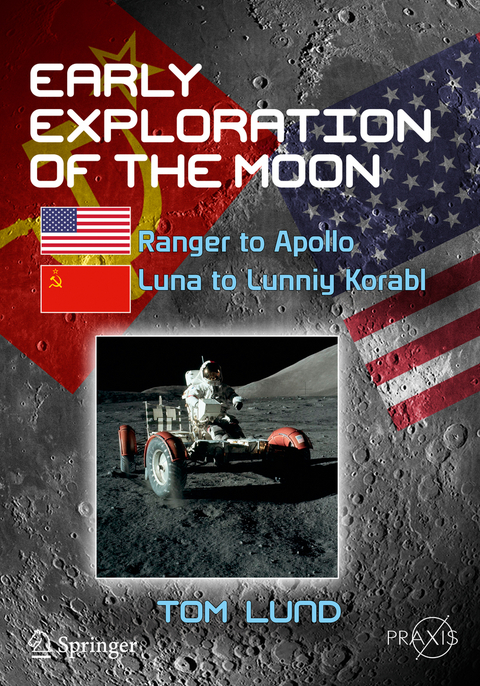
Early Exploration of the Moon
Springer International Publishing (Verlag)
978-3-030-02070-5 (ISBN)
Luna 2, launched by the USSR in 1959, was the first spacecraft from Earth to land on the moon. That first voyage was followed by increasingly capable lunar exploration spacecraft from Russia and the United States. A total of 36 successful lunar exploration missions were conducted from 1959 to the last Apollo manned exploration in 1972 and the final travels of the Lunokhod lunar rover in 1973. Of all the missions, that of Apollo 17 was the pinnacle of manned space exploration. Apollo 17 astronauts traveled 21 miles on the lunar surface in a dune buggy-type vehicle, stopping frequently to explore and gather samples.
The spacecraft that enabled lunar exploration were ingenious, and reflected the best efforts of talented people working with the technology of the day. This book showcases the engineering involved in those incredible machines. The spacecraft covered, and their missions, are listed below.From the United States:
- Ranger - Photography en route to lunar impact
- Lunar Orbiter - Photography of front and back side of moon
- Surveyor - Soft landing, photography, and soil analysis
- Apollo - Manned exploration. Lunar Rover expanded range
From the USSR:
- Luna 2 - Photography en route to lunar impact
- Luna 3 - Photography of back side of moon on flyby
- Luna 9 and 13 - Soft landing, photography, and soil analysis
- Luna 10, 11, 12, 14 - Photography from lunar orbit
- Luna 16, 20, 24 - Soft landing, return of soil sample to Earth
- Lunokhod-1, -2 - Lunar roving vehicle driven from Earth
- L1 - Planned manned lunar flyby but only flew unmanned
- L3 - Planned manned lunar landing but never flew to moon
To tell the story of these spacecraft, Tom Lund draws on over 40 years' work on aircraft and spacecraft systems. He was technical lead for the landing radars for the Surveyor and Apollo spacecraft, and his practical experience is augmented by master's degrees in electrical engineering, physics, and business administration.Thomas Lund worked 50 years as an aerospace engineer. After graduating from college, he began working on the Terrier surface-to-air missile from initial design to flight test. He then spent three years as Electronics Officer in the U.S. Navy evaluating naval air-to-air missile systems against electronic countermeasures. He went on to analyze the Doppler navigation systems and then functioned as technical lead for development of the landing radar for the Surveyor spacecraft. He was instrumental in winning the contract for the landing radar for the Apollo Lunar Module and functioned as technical lead for development of that radar. He worked as Technical Director of the Advanced Systems group for a major aerospace company and led the development of three new product lines in areas of fiber optics, radar altimeters, and missile detection radars. Latterly, he was a consultant for predesign and analysis of the Rendezvous Radar for the Space Shuttle.
Dedication.- Introduction.- Chapter 1:The Nature of the Moon.- Chapter 2: The Ranger Lunar Photography Mission.- Chapter 3: The Lunar Orbiter Mission.- Chapter 4: The Surveyor Lunar Landing Mission.- Chapter 5: The Apollo Manned Exploration of the Moon.- Chapter 6: The Apollo Command Module.- Chapter 7: The Apollo Service Module.- Chapter 8: The Apollo Lunar Module.- Chapter 9: Apollo Crew Personal Equipment.- Chapter 10: Lunar Roving Vehicle and Exploration of the Moon.- Chapter 11: Russian Launch Vehicles, Lunar Impactors and Flybys.- Chapter 12: Russian Soft Landers, Orbiters,and Rovers.- Chapter 13: Russian Manned Circumlunar Spacecraft.- Chapter 14: Russian Manned Lunar Landing Endeavours.- Bibliography.- Index.
"For anyone interested in learning more about the technology behind Apollo and its predecessors, I would recommend this book as an interesting and useful reference." (Peter Bond, The Observatory, Vol. 139 (1273), December, 2019)
“For anyone interested in learning more about the technology behind Apollo and its predecessors, I would recommend this book as an interesting and useful reference.” (Peter Bond, The Observatory, Vol. 139 (1273), December, 2019)
| Erscheinungsdatum | 01.12.2018 |
|---|---|
| Reihe/Serie | Space Exploration | Springer Praxis Books |
| Zusatzinfo | XIII, 391 p. 193 illus., 92 illus. in color. |
| Verlagsort | Cham |
| Sprache | englisch |
| Maße | 168 x 240 mm |
| Gewicht | 762 g |
| Themenwelt | Sachbuch/Ratgeber ► Natur / Technik ► Technik |
| Technik ► Luft- / Raumfahrttechnik | |
| Schlagworte | apollo command module • Apollo Program • apollo service module • Cold War lunar exploration • l1 • L3 • LK lander • LOK orbiter • lunar roving • Lunokhod • Moon missions • Ranger lunar photography • Russian Luna • Russian lunar exploration • Surveyor lunar landing |
| ISBN-10 | 3-030-02070-3 / 3030020703 |
| ISBN-13 | 978-3-030-02070-5 / 9783030020705 |
| Zustand | Neuware |
| Haben Sie eine Frage zum Produkt? |
aus dem Bereich


